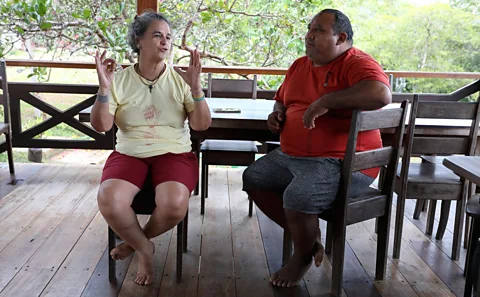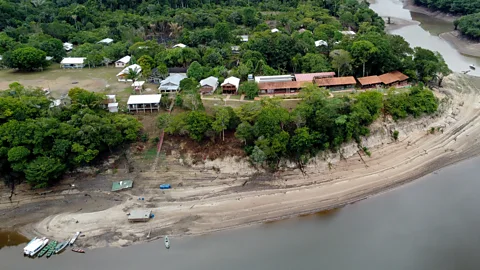The logger who learned the value of living trees
 Michael Dantas and United Nations Foundation
Michael Dantas and United Nations FoundationRoberto Brito learned how to use a chainsaw at the age of 11. Now he uses his intimate knowledge of the Amazon rainforest to guide tourists around in his flip-flops.
It used to be that when Roberto Brito looked at a tree, he would see a number: the amount of money he could earn from chopping it down.
Brito and his family, who live along the Rio Negro in the Brazilian Amazon, only saw the monetary value of logged trees. He learned how to use a chainsaw at the age of 11, and represented his family's fourth generation of men cutting down trees before they became legal adults.
At first Brito found it hard to see a beautiful tree, which he knew would produce good timber, without cutting it down. Resisting this impulse was excruciating, like quitting smoking, he says.
Now, when Brito looks at a tree, everything has changed. "We stopped thinking about price and started thinking about [a different kind of] value. For example, when I see a beautiful cumaru [Brazilian teak] tree, 300 to 400 years old, with a little over a metre in diameter, and 15-20m (49-66ft) long, I still touch it, but with a different mindset," he reflects.
 Michael Dantas and United Nations Foundation
Michael Dantas and United Nations Foundation"When I was a logger, I would touch a tree like that and say, 'I’ll spend three or four days working and I'll make 800 or 700 reais' (approx. £108–123, or $144-164). I still think about making money, but maybe I can make the same 700, 800, or even 1,000 reais through a hike with 10 people, for example. And I realised that through that standing forest, I have access to education, technology, a future for the young people living here, and I still contribute to the preservation of our planet in relation to climate change."
Brito's transition, from cutting down the forest to leading hikes in it, was dramatic. It required the support and alignment of financial, social and environmental incentives. His story suggests that with the right combination of encouragements, and by tapping into the knowledge and skills of people working within an extractive industry, there may be a viable path out of it for some.
A new reserve
Tumbira, the ribeirinho (river dweller) village where Brito lives, has a scattering of buildings amidst lush trees. To reach the heart of the community, visitors climb an outdoor wooden staircase from the shore, near otters poking their mouths out above the surface of the water.
The Pousada do Garrido, a five-room lodge, is the first stop for many entering Tumbira for the first time. The lodge’s main meeting space has a metal roof and an immaculately clean floor made out of wooden planks. It’s open to the sides, with a colourful forest mural framing the kitchen.
Skinny dogs trot around, while vultures stand alert on the goalposts of the nearby football pitch. Tumbira has long been a place of remote tranquillity. But it’s been reshaped in the past few years, with the introduction of low-impact tourism.
In 2008, the government of the Brazilian state of Amazonas created the Rio Negro Sustainable Development Reserve, in order to preserve nature and to support communities living within it. Rita Mesquita, an ecologist at the National Institute of Amazonian Research (Inpa), says that compared to previous eras, there's been huge progress in terms of recognising people's rights to the land where they are.
While the creation of other types of Brazilian reserves could lead to the displacement of people who had been living there for generations, a sustainable development reserve values the residents. "We need to look at these people as partners and allies in conservation," Mesquita says. This attitude, she says, creates partners for life.
However, a sustainable development reserve does involve restrictions on resource extraction. Brito's livelihood, which was already physically exhausting, became tougher. Environmental agencies were conducting logging inspections and arrests. Prices for timber were dwindling. So were the trees themselves, inciting competition among loggers.
Brito admits, in his matter-of-fact way, that he continued logging illegally. "I had to have some income," he says. "I strongly defended timber extraction because I didn't think of working with anything else. I said I would never stop logging."
But over the next few years Brito started to notice other changes in his village of Tumbira, where he was serving as community president. For instance, the designation of the sustainable development reserve led to organisations including the Foundation for Amazon Sustainability (FAS) establishing education and health projects there. Formal education was something he badly wanted for his two teenage sons. He himself had only received five years of schooling.
Another change was that tourists from other Brazilian states had started to visit the conservation project in the reserve. They wouldn't stay overnight because there was nowhere for them to sleep; instead they took the boat back to the nearest city, Manaus, several hours away.
From forest cutting to forest guiding
Brito recalls that one day Virgilio Viana, the director general of FAS, suggested that he might like to work in community-based tourism. "I looked at him, astonished, and said, 'What am I going to do with people from outside [the forest]'? There was a very big barrier."
But Brito decided to try. "I started receiving people in my own home to check what that experience would be like," Brito says. This trial was a success. He realised that he earned more in a week than he had ever seen in three months of logging. In 2011 – three years after the creation of the sustainable development reserve and over two decades since he cut down his first tree – Brito opened his nature lodge. And he put down his chainsaw.
Brito's lodge, the Pousada do Garrido, became the first company to graduate from FAS' Forest Business Incubator, which provided access to credit, training and other resources helpful to Amazonian community businesses. "Community-based tourism that relies heavily on ecosystem services is considered by us [FAS] as part of the bioeconomy," says Viana. "It's more likely that me or you in London overconsume and overstress the planet than they would."
 Michael Dantas and United Nations Foundation
Michael Dantas and United Nations FoundationBrito's three-year transition away from logging reflects the foundation's gradual approach to building trust and identifying community priorities. In the beginning there was a lot of resistance from people who didn't expect to be able to earn a living without logging, Viana says. "That is an opportunity to talk about the importance of capacity building and education," he says, adding that this happens on residents' own terms.
"I never dreamed of working in tourism," Brito says. But as an entrepreneur, he's able to apply his intimate knowledge of the forest to tourism instead of logging. This has transformed not only his work, but also his relationship to the forest. "I realised that eating the fruits of a tree every year is much better than cutting down the tree all at once and taking out a hundred pieces of wood."
There have been ups and downs with the business. Chief among these is drought. In 2023, a historically long-lasting drought presented huge challenges for a village that can only be accessed by river.
As the river dried up, so did the reservations at the lodge. The bookings of 111 visitors had to be cancelled, Brito says. He explains this directly affected 15 families in Tumbira whose work is connected to the business, such as making crafts, fishing and cleaning.
Even so, Brito says, tourism within a sustainable development reserve is better business than logging. It also brings a better quality of life: he can sleep at home next to his wife, his community has access to healthcare and technology, and there's great satisfaction in knowing that trees and other environmental resources will still be around several generations from now.
Scaling up change
As a former community president, and as one of 10 siblings, Brito has considerable social influence. Some of his brothers have also swapped logging for sustainable tourism.
This kind of social contagion can be a powerful force for environmental benefit. Anne Toomey, an associate professor in environmental studies at Pace University in the US, points to research suggesting that often, "we need a redundancy within our social network" in order to spread social change. In other words, it can feel too risky to make an environmental change unless multiple other people in one's social network have also done so. Once a critical mass is achieved within a geographical area, such as a number of people have installed solar panels, this can then spill over into the surrounding areas. However, there's a danger of uneven investment, which can breed inequality and resentment, Toomey says.
The transformation of the village of Tumbira into a hub of ecotourism has taken the coordinated efforts of many people. It's not necessarily representative of many other Amazonian ribeirinho communities. But it shows what's possible, and the inspiration has already spread to neighbouring villages, according to Viana.
 Getty Images
Getty ImagesAnother lesson is that moving away from blaming or shaming individuals can bring more people into the environmental movement, says Toomey. So can valuing people's prior experiences, such as Brito drawing on his decades of logging as he guides visitors around the forest in his flip-flops.
For too long, Toomey believes, the environmental movement has sought to change people's ideologies, when actions ultimately matter more than ideological purity. "There's some power in creating a broader definition of what an environmentalist can look like," she says. Her research on what ultimately motivates change for conservation suggests that a more pragmatic view can be helpful. For instance, financial incentives "can be synergistic with other types of incentives".
For Brito, sustainability is about actions rather than 'pretty speeches', he says. "I'm not an environmentalist or a radical activist. I just defend what is working in our community and what is strengthening the community as a whole," Brito says. "'Sustainability' is a very long, difficult word to say, but it's not difficult to achieve. You just need support, and the local people need to want it too. That's what we're doing."
*This reporting was made possible with support from the UN Foundation's Thomas Lovejoy Memorial Press Fellowship. The author would like to acknowledge the help of Guilherme Cavalcante who translated for some of the interviews in this article.
--
For essential climate news and hopeful developments to your inbox, sign up to the Future Earth newsletter, while The Essential List delivers a handpicked selection of features and insights twice a week.
